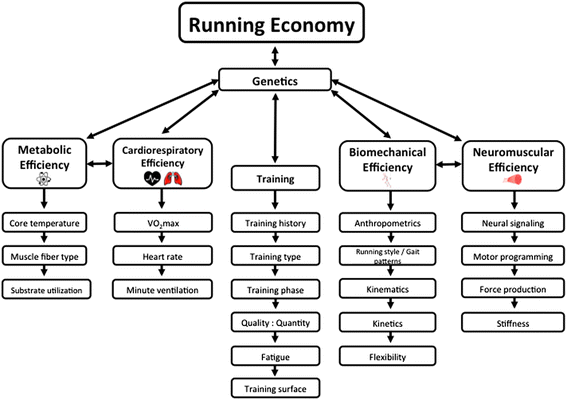Factors That Affect Running Economy
By Adam Crick | Running Coach at Community Cadence
Running economy is a multifactorial concept that integrates metabolic, cardiorespiratory, biomechanical and neuromuscular characteristics unique to the individual (as seen in the figure 1 below).
However many of the determining factors of running economy can be adapted through training.
Fiqure 1: Factors Affecting Running Economy (Barnes & Kidling 2015)
Factors That Can Be Adjusted To Improve Running Economy
Stride length and stride frequency
Vertical Oscillation
Foot strike patterns
Vertical Oscillation
Reducing vertical oscillation minimises unnecessary mechanical work and energy expenditure.
Running is about moving forwards, not up and down! So as a general rule, the lower your vertical oscillation, the more efficient you’ll become.
Stride Length and Frequency
To overcome long stride lengths, and low stride rates, the musculoskeletal system is required to generate greater external power during propulsion to counteract the increased breaking forces during footstrike.
Conversely, at increased stride rates accompanied by shorter stride lengths, the mechanical power required for limb movement increases due to the elevated frequency of reciprocal segmental motions.
Research suggests that there is little need for most runners to change thier stride lengths since they already tend to display near optimal stride lengths..
Foot Strike
Simply put, Braking forces are forces that stop you moving forward. The classic example is over-striding.
As illustrated, the runner on the left lands with their foot positioned well ahead of the knee (over striding), which leads to a significant ground reaction force opposing forward motion, essentially acting like a braking mechanism.
In contrast, the runner on the right makes contact with the ground with thier midfoot, allowing for a smoother, more efficient transition that maintains forward momentum with minimal disruption.
However an economical change in one athlete may be uneconomical in another athlete because of differences in other physiological or biomechanical characteristics (Barnes & Kidling, 2015)
Interested in Working on Your Running Economy?
At Community Cadence Running Coaching, we specialise in tailored programs that fit your lifestyle, adapt to your goals, and integrate proven strategies to improve performance.
Whether you're chasing your first 10K or going after a marathon PB, we can help you become a more efficient, faster runner — one session at a time.
References
Barnes, K. R., & Kilding, A. E. (2015). Running economy: measurement, norms, and Determining Factors. Sports Medicine - Open, 1(1). https://doi.org/10.1186/s40798-015-0007-y
Williams, K. R., & Cavanagh, P. R. (1987). Relationship between distance running mechanics, running economy, and performance. Journal of Applied Physiology, 63(3), 1236–1245. https://doi.org/10.1152/jappl.1987.63.3.1236
